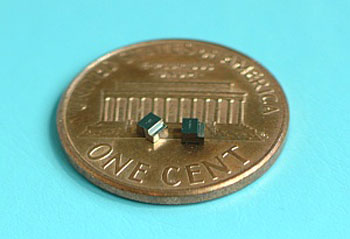 Transistors are commonly used in electronics as switches to turn an electrical current on or off. For applications that require a very large ratio between the on and off current, however, it is necessary to use mechanical 'reed' switches, in which magnetic fields physically move metallic wires (or reeds) towards and away from electrical contact points. As devices become more compact, these mechanical switches need to be miniaturized into small packages, without sacrificing performance.
Transistors are commonly used in electronics as switches to turn an electrical current on or off. For applications that require a very large ratio between the on and off current, however, it is necessary to use mechanical 'reed' switches, in which magnetic fields physically move metallic wires (or reeds) towards and away from electrical contact points. As devices become more compact, these mechanical switches need to be miniaturized into small packages, without sacrificing performance.
Apr 13th, 2011
Read more
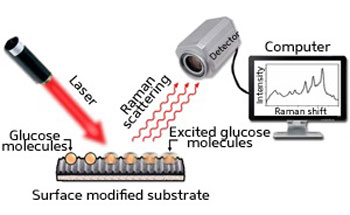 New substrates boost the sensitivity of surface-enhanced Raman spectroscopy for the detection of glucose at physiological concentrations.
New substrates boost the sensitivity of surface-enhanced Raman spectroscopy for the detection of glucose at physiological concentrations.
Apr 13th, 2011
Read more
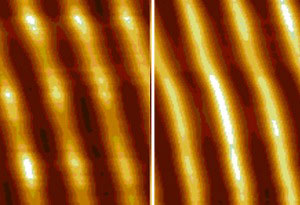 Atomic force microscopy (AFM) is a highly sensitive form of microscopy that makes it possible to map a surface with near-atomic resolution. Shaw Wei Kok and colleagues from A*STAR's Singapore Institute of Manufacturing Technology have now developed an AFM measurement method that can improve the sensitivity of the technique even further.
Atomic force microscopy (AFM) is a highly sensitive form of microscopy that makes it possible to map a surface with near-atomic resolution. Shaw Wei Kok and colleagues from A*STAR's Singapore Institute of Manufacturing Technology have now developed an AFM measurement method that can improve the sensitivity of the technique even further.
Apr 13th, 2011
Read more
Nearly 100 middle-school students from three Capital Region schools experienced the convergence of "Nanotechnology and Nature" during an educational outreach program presented by the College of Nanoscale Science and Engineering (CNSE) of the University at Albany on April 12 at the Albany Pine Bush Preserve Discovery Center.
Apr 12th, 2011
Read more
Fatih Uckun, MD, PhD, head of Translational Research in Leukemia and Lymphoma at the Children's Center for Cancer and Blood Diseases at Children's Hospital Los Angeles, and a research professor of Pediatrics at the Keck School of Medicine of the University of Southern California, has been awarded $1.7 million from the National Cancer Institute (NCI) to support development of a new strategy to overcome the resistance of cancer cells to radiation therapy.
Apr 12th, 2011
Read more
The European Commission's hesitance to define nanotechnology underscores diverging opinions among stakeholders and is causing uncertainty in the sector.
Apr 12th, 2011
Read more
An electrical engineer at the University at Buffalo, who previously demonstrated experimentally the "rainbow trapping effect" -- a phenomenon that could boost optical data storage and communications -- is now working to capture all the colors of the rainbow.
Apr 12th, 2011
Read more
Microscopically tiny ferromagnetic platelets exhibit a phenomenon which could be exploited in the future for particularly stable magnetic data storage: so-called magnetic vortex cores. Five years ago, researchers at the Max Planck Institute for Intelligent Systems found a way to reverse the magnetic field needles despite their stability using only a tiny amount of energy so that their tips pointed in the opposite direction. Such a switching process is necessary to enable the vortex cores to be used in data processing. The Stuttgart scientists have now discovered a new mechanism which makes this switching process at least 20 times faster and confines it to a far smaller region than before.
Apr 12th, 2011
Read more
A new study finds that the general public thinks getting a suntan poses a greater public health risk than nanotechnology or other nanoparticle applications.
Apr 12th, 2011
Read more
'Quantum coaxial cable' nanostructure efficiently harvests visible wavelength light using stable, high bandgap semiconductors.
Apr 12th, 2011
Read more
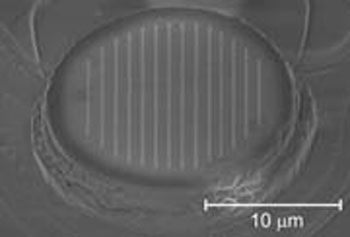 Elektronenmikroskope nutzen einen fokussierten Elektronenstrahl, um winzige Objekte sichtbar zu machen. Wird das Instrument mit einem Gasinjektionssystem kombiniert, lassen sich Materialproben manipulieren und nanometerfeine Oberflaechenstrukturen darauf "schreiben". Empa-Forschende haben mit Wissenschaftlern der EPFL diese Methode nun genutzt, um Laser zu verbessern.
Elektronenmikroskope nutzen einen fokussierten Elektronenstrahl, um winzige Objekte sichtbar zu machen. Wird das Instrument mit einem Gasinjektionssystem kombiniert, lassen sich Materialproben manipulieren und nanometerfeine Oberflaechenstrukturen darauf "schreiben". Empa-Forschende haben mit Wissenschaftlern der EPFL diese Methode nun genutzt, um Laser zu verbessern.
Apr 12th, 2011
Read more
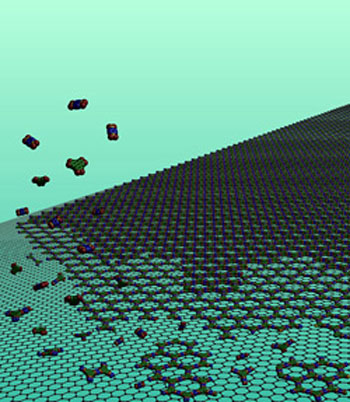 Solar cells made from organic materials are inexpensive, lightweight and flexible, but their performance lags behind cells that contain silicon or other inorganic materials. Cornell chemist William Dichtel and colleagues have found a way to synthesize ordered organic films that could be a major step toward solving this problem.
Solar cells made from organic materials are inexpensive, lightweight and flexible, but their performance lags behind cells that contain silicon or other inorganic materials. Cornell chemist William Dichtel and colleagues have found a way to synthesize ordered organic films that could be a major step toward solving this problem.
Apr 12th, 2011
Read more
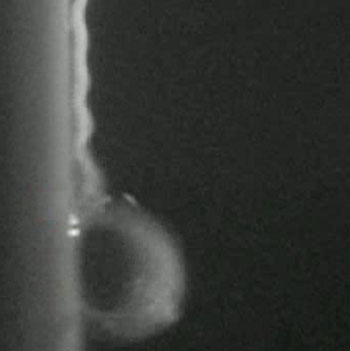 A new study details the different physical conditions needed to destabilize a fluid and create droplets according to the wetting properties of the surface it is in contact with.
A new study details the different physical conditions needed to destabilize a fluid and create droplets according to the wetting properties of the surface it is in contact with.
Apr 12th, 2011
Read more
An initiative that aims to complement the support provided by the offices of technology transfer is the European Commission-funded project ProNano - Promoting Technology Transfer of Nanosciences, Nanotechnologies, Materials and new Production Technologies. Ten companies from Spain, Germany, the UK, Italy, Denmark and France have joined forces within ProNano, to help 30 research groups develop attractive investment propositions and get in contact with interested investors.
Apr 12th, 2011
Read more
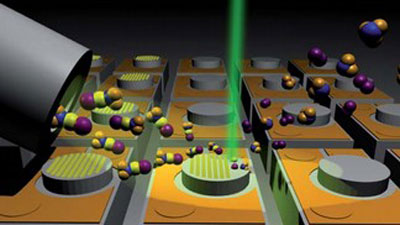 A new laser procedure could boost optical fiber communications. This technique could become essential for the future expansion of the Internet. It also opens up new frontiers in basic research.
A new laser procedure could boost optical fiber communications. This technique could become essential for the future expansion of the Internet. It also opens up new frontiers in basic research.
Apr 12th, 2011
Read more
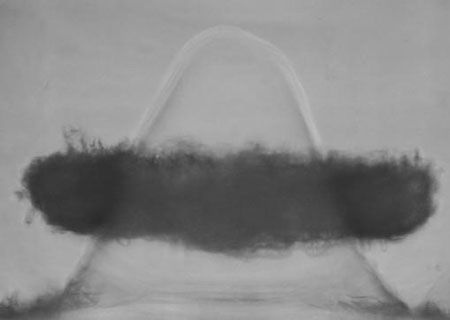 As cells assemble into a doughnut shape and ascend a hydrogel cone, they do work and thereby reveal the total power involved in forming a three-dimensional structure. That measure not only could help tissue engineers understand their living building materials better, but could also add insight to the understanding of natural tissue formation.
As cells assemble into a doughnut shape and ascend a hydrogel cone, they do work and thereby reveal the total power involved in forming a three-dimensional structure. That measure not only could help tissue engineers understand their living building materials better, but could also add insight to the understanding of natural tissue formation.
Apr 12th, 2011
Read more
 Transistors are commonly used in electronics as switches to turn an electrical current on or off. For applications that require a very large ratio between the on and off current, however, it is necessary to use mechanical 'reed' switches, in which magnetic fields physically move metallic wires (or reeds) towards and away from electrical contact points. As devices become more compact, these mechanical switches need to be miniaturized into small packages, without sacrificing performance.
Transistors are commonly used in electronics as switches to turn an electrical current on or off. For applications that require a very large ratio between the on and off current, however, it is necessary to use mechanical 'reed' switches, in which magnetic fields physically move metallic wires (or reeds) towards and away from electrical contact points. As devices become more compact, these mechanical switches need to be miniaturized into small packages, without sacrificing performance. 







 Subscribe to our Nanotechnology News feed
Subscribe to our Nanotechnology News feed